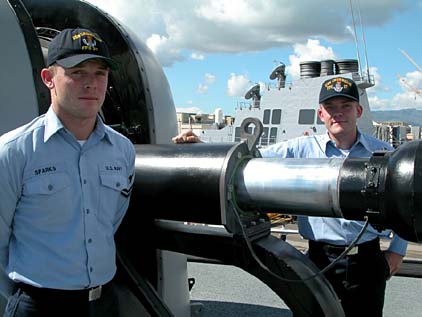
U.S. NAVY PHOTO
The Pearl Harbor-based frigate USS Crommelin with its MK13 missile launcher near the bow of the ship before it was removed.
Pearl Harbor frigate
upgrades armamentsThe USS Crommelin retires
its old missiles and will receive
a rocket decoy system
Twenty-two-year-old Petty Officers Matthew Sparks and Ryan Shipp weren't even born when the Pearl Harbor-based frigate USS Crommelin was launched with its MK13 guided-missile system.
Under a Pentagon cost-cutting and modernization move, the missile launchers -- known as "one-armed bandits" because they use a single rail that elevates the missile -- are being removed from the Navy's 30 frigates.
Two Pacific Fleet frigates -- the USS Reuben James and Crommelin -- call Pearl Harbor home and have already completed the conversion. The launcher was taken off the James in August and the Crommelin removed its in October.
Lt. j.g. Matthew Price, Crommelin's gunnery officer, said removal of the missile launcher is "the first step in improving the operations of my ship and makes frigates a better fighting machine."
GREGG K. KAKESAKO / GKAKESAKO@STARBULLETIN.COM
Petty Officer Matthew Sparks, fire control system maintenance and operations specialist, and Petty Officer Ryan Shipp, who maintains all the weapons on the USS Crommelin, both agree that it was hard to maintain the MK13 guided missile launching system, which was placed in use before they were born.
The Perry-class guided-missile frigate will now rely on a MK-75 76 mm cannon and a 20 mm Phalanx Close-in Weapons System, a modern-day Gatling gun, as its last line of defense against incoming missiles and other threats. It also will have two Seahawk helicopters armed with anti-aircraft missiles.
Matthew Price: The Navy officer says the ship's improvements will save money
The Crommelin also will get a new missile decoy system called Nulka. "It uses rockets that hover off the ship, creating an electromagnetic signal designed to fake out incoming missiles," Price said.
Two banks of torpedo tubes are also part of its weapons system.
Frigates in today's Navy are the modern version of destroyer escort warships and provide both anti-air and anti-submarine protection for an amphibious expeditionary group or an aircraft carrier battle group.
Price said the 23-year-old Crommelin is in line to get an upgraded version of the CIWS -- which looks like the R2D2 robot from "Star Wars." The CIWS, which sets on either side of the frigate, will include optical and infrared sights, in addition to its radar aiming system.
Price said "the thermal imaging camera will allow the Crommelin to engage small surface vessels and give us another avenue of defense."
He describes the CIWS as "one of my favorite weapons because it shoots so fast."
Both Price, who has been in the Navy for four years, and Chief Petty Officer Jack Black, the senior enlisted gunnery officer, have fired the MK13 missile system only in practice.
The Navy said the only combat use of the MK13 system was in 1988 when a frigate sank an Iranian gunboat with a SM-1 missile.
For the nearly 20 years, Black, 43, has been in uniform he has only seen the MK13 used against practice drones.
Shipp, whose job is to maintain Crommelin's seven weapons systems, admits the missile system was hard to maintain.
"We had to do a lot of daily maintenance," said Shipp. "It ... caught a lot of sea spray."
Shipp said that his crew had to spend at least two hours every day wiping off the old grease, adding new grease and checking the fluid levels.
"The part of the daily routine also included moving the rail system up and down and around in circles," he added.
Price said that the change means "I will be able to work with less, saving the Navy a lot of money over the long haul."
There also was the headache of getting the right parts.
"Sometimes parts were hard to come by," Price added, "or were very expensive."
By comparison, Sharp said the 76 mm cannon on the mid-section of 453-foot Crommelin is "easier to maintain."
The Navy plans to keep frigates in service for another 16 years and decommission each one as they reach the end of their 30-year life span.
A new generation of small, high-speed warships that would operate in coastal waters is being developed.


